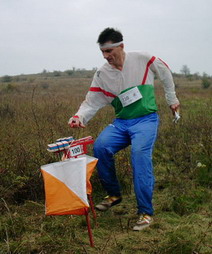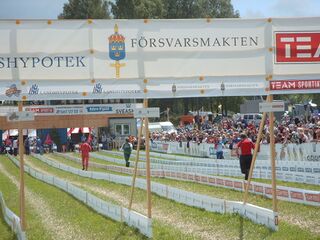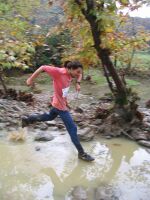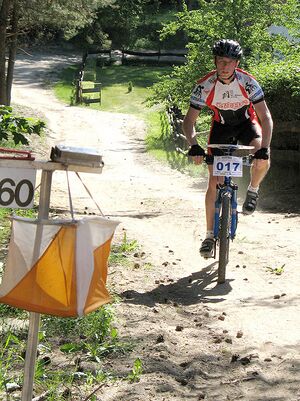Orienteering
Orienteering is a running sport involving navigation with a map and compass. The traditional form (sometimes referred to as "Foot Orienteering" or "Foot-O") involves cross-country running, though other forms have evolved. The competition is a timed race in which individual participants use a special purpose map and a magnetic compass to navigate through diverse terrain (often wooded) and visit, in sequence, control points that are indicated on the map. The course of control points is kept a secret from competitors before the start, when they are provided with a detailed topographic map on which the course is marked. Competitors start at staggered intervals, are individually timed, and are expected to perform all navigation skills on their own. Standings are determined first by successful completion of the course, then by shortest time on course. Rules and principles of the sport are defined by the International Orienteering Federation.
The English name derives from the Swedish word "orientering". The term was first used to describe the sport in 1918 by Major Ernst Killander, then President of the Stockholm Amateur Athletic Association, in publicity for the first large scale competitive meet held in Sweden.[1]
History
Early days
Orienteering originated in Scandinavia, as a military exercise, in the late 19th century. The competitive sport form began in Norway where the first competition was sponsored by the Tjalve Sports Club on 31 October 1897 and held near Oslo. The course was quite long by modern standards, at 19.5 km, on which only three controls were placed. Peder Fossum won the event in a time of 1 hour, 47 minutes, and 7 seconds.[2] The first large scale orienteering meet was organized in 1918 by Major Ernst Killander of Stockholm, Sweden. Killander was a Scout leader who turned to the sport as an opportunity to interest youth in athletics. The first large scale event was organized south of Stockholm and was attended by 220 athletes.[2][3] Killander continued to develop the rules and principles of the sport, and today is widely regarded throughout Scandinavia as the "Father of Orienteering".
The sport gained popularity with the development of more reliable compasses in the 1930s. The first international competition between orienteers of Sweden and Norway was held outside Oslo, Norway in 1932. In 1933, the Swedish compass manufacturer Silva Sweden AB introduced a new compass design, the protractor compass. Until the development of thumb compasses, the protractor compass would remain the state of the art in the sport. By 1934, over a quarter million Swedes were actively participating in the sport, and orienteering had spread to Finland, Switzerland, the Soviet Union, and Hungary. The nations of Finland, Norway, and Sweden all established national championships.[4] The Swedish national orienteering society, Svenska Orienteringförbundet, the first national orienteering society, was founded in 1936.[5]
Post war years
Following World War II, orienteering spread throughout Europe, Asia, North America, Australia, and New Zealand. The first orienteering event held in North America took place in November, 1941 at Dartmouth College, in Hanover, New Hampshire, USA, organized by Piltti Heiskanen, a visiting student from Finland. Bjorn Kjellstrom (d. 1995), a Swedish orienteer and co-founder of compass manufacturer Silva Sweden AB, moved to the United States in 1946 to found the U.S. operations of The Silva Company (later Silva, Inc.). Kjellstrom brought his love for orienteering with him, inaugurating Silva Orienteering Services to provide training and company sponsorship for the sport. With Norwegian Harald Wilbye, Kjellstrom would help found a U.S. orienteering club in 1967 that became one of the largest and most active orienteering clubs in the United States.[6] The Canadian Orienteering Federation was also founded in 1967, and the first Canadian national orienteering championship was held at Gatineau Park in Ottawa on August 10, 1968.[7] The only World Championship to be held in North America took place at West Point, New York, USA in 1993.
Eleven countries sent representatives to an international conference in Sandviken, Sweden in 1949 that aimed to bring more consistent rules and mapping standards to the sport. The Norwegians and Swedes began producing new multi-color maps designed specifically for orienteering in the 1950s. The first orienteering event in Australia was held in 1955. The International Orienteering Federation (IOF) was established in 1961 and the first world championships were held in 1966. The founding member societies represented the nations of Bulgaria, Czechoslovakia, Denmark, the Federal Republic of Germany, the German Democratic Republic, Finland, Hungary, Norway, Sweden, and Switzerland. By 1969, the IOF would represent 16 countries, including the first two non-European member societies representing Japan and Canada.[8]
Recent years
Sixty-seven different national orienteering federations are member societies of the IOF today.[9] World championships were held biannually from 1961 to 2003, and are now held every year. Jukola relay and Tiomila have both been held since the 1940s. The largest individual orienteering meet, O-Ringen, has been held annually since 1965 and attracts around 15,000 athletes to compete in the Swedish forests. There are new variations of the sport, including ski orienteering, mountain bike orienteering, trail orienteering, canoe orienteering, and radio orienteering that attract diverse communities of athletes. The sport has been dominated by the Nordic nations and Switzerland, but increasingly France, Great Britain and several Eastern European countries are making their mark. Outside Europe, Australia and New Zealand are the most developed orienteering nations. With the death of Bjorn Kjellstrom and the absence of active corporate sponsorship, U.S. orienteering has remained somewhat moribund in terms of participation in recent years.
Orienteering and the Olympics
Efforts begun in 1996 to promote the inclusion of orienteering in the Olympic Games have so far been unsuccessful, although orienteering became a sport in the World Games in 2001, and is a sport in the Summer Deaflympics. Supporters recognize that the sport is neither television nor spectator friendly, the venue of competition is often necessarily remote from major cities, and the duration of the event is longer than most other individual competitions.[10] Efforts to develop a format suitable for Olympic competitions have focused on park orienteering, micro-orienteering, and short distance relays.
Ski orienteering has been promoted as the format of the sport most likely to be included in Olympic Games. Although not an official demonstration sport, an international ski-orienteering event was held in Sugadaira, Japan as part of the International Cultural Festival held in conjunction with the XVIII Winter Olympic Games in Nagano in 1998.[11] The International Orienteering Federation petitioned the International Olympic Committee in 2002 to include ski orienteering in the 2006 Winter Olympic Games, noting that it could share the venue with the biathlon competitions.[12] In its formal recommendation that ski orienteering not be included in those games, the Olympic Programme Commission focused on a lack of participation in the sport outside Nordic countries, "the challenges for broadcasters and spectators to easily follow the competition", and the costs associated with new technology and a new results system.[13] In 2005, the International Olympic Committee confirmed that ski orienteering was under consideration for inclusion in the review process of the Olympic sport program for the 2014 Winter Olympic Games. [14] On November 28, 2006, the Executive Board of the IOC decided not to include ski orienteering into this review process.[15]
Basics
An orienteering course is marked in purple or red on a map using a triangle to indicate the start and a double circle to indicate the finish. Circles are used to show the control points. A staggered start is often used, with competitors starting at one or two-minute intervals. Results are based on the time taken to complete the course, visiting all the controls in the correct order.
High levels of fitness and running speed are required to compete successfully at an elite level. Success is also heavily dependent on choosing the fastest route between controls. While controls are generally the same for the competitors in any particular category, the routes they choose may be very different. Competitors are often required to cross rough, undeveloped terrain where accurate navigation is essential.
Orienteering races usually offer a range of courses with varying physical and technical difficulty to appeal to competitors of differing abilities. Often courses are classified by age class, e.g., M35 for men 35 years of age and older. Sometimes several courses are available for each age class, e.g., W18L: women 18 years and younger long course, W70S: women over 70 short course, M21E: men's open elite etc.
Some countries, such as the United States or the United Kingdom, use color-coded courses at smaller races to define the difficulty of the courses. A "white" course, for instance, might be a short, easy course aimed at beginners whilst a "blue" course would be both technically and physically more demanding.
Recently some local orienteering clubs have begun to organize orienteering courses solely for fitness purposes. These may be permanent courses, and are used for practice and training. Maps of the courses are usually available publicly for a fee. Sometimes these are collected back after completing the course, and certainly so if the course is later intended also for competitive orienteering. All major competitive events should have completely new control points on the course, and the general area of the competition can be closed for competitors during the construction of the course.
Map and control details
<imagemap> Image:Orienteringskort bygholm 2005 detail.jpg|thumb|right|420px|Detail of a map used in orienteering: the course is usually overprinted in red or magenta. Click for full map. Map drawn by Tage Baun and Preben Jørgensen for Horsens OK
rect 0 0 420 240 Image:Orienteringskort bygholm 2005.jpg </imagemap>
Maps are specially created by orienteers and professional mapmakers. They are a larger scale and much more detailed than general-purpose topographic maps, and are typically at scales of 1:15,000 or 1:10,000, with grids predrawn to magnetic north. Map symbols for the 1:15000 scale are standardized by the IOF (International specification for orienteering maps - ISOM), and designed to be readable by any competitor no matter his background or native tongue. Map symbols for the 1:10000 scale shall be a 150% enlargement of the symbols for the 1:15000 scale. Map reading and terrain association are supreme in orienteering navigation, and the compass is normally reduced solely to the role of orienting the map to magnetic north.
Control points are usually placed on distinct features, and clarified on a "control description sheet". They are marked in the terrain by white and orange (or white and red) flags, like that illustrated above. A competitor registers his or her visit by punching a "control card" with a needle punch, or using an electronic chip.
Equipment and clothing
The basic equipment required for orienteering is usually listed as a compass, appropriate outdoor clothing and, in some countries, whistle. The whistle is for use in emergency situations. Competitive orienteers usually use specialized equipment, such as a "thumb compass". A clear plastic sleeve is worn on the forearm to hold control descriptions. Competitors may also use a "punch-card holder" for hands-free orienteering. A modern variation on the punch card is electronic punching. There are two types of electronic punching. One is a small plastic 'punchcard' (also called a 'dibber'), which straps to a competitor's finger and is inserted into a special, battery-operated station at the control point. The other is a system known as 'Emit' which has more of a brick-like shape but follows the same principle as the 'dibber,' with the added backup of a small card. This card is pierced by a pin in a specific location at each station. With both, the time at which the control was punched is recorded. Some electronic punching systems have stations that beep and/or flash a light to notify that the punch is OK. For important events there should be some kind of independent backup available in case of equipment failure.
Purpose-made lightweight nylon or lycra suits provide full body cover for racing in areas with undergrowth. Gaiters are also often worn. Lightweight studded (and often cleated) orienteering shoes are commonly used. People sometimes wear visors to keep rain, dust and twigs out of their eyes. GPS and other electronic navigation devices are not normally allowed.
Race types
World Championship distances are Long (winning time of 70 - 80 minutes for women and 90 - 100 mins for men), Middle (30-35 mins), Sprint (10-12 mins) and Relay.
- Relay - Teams of competitors each run a course and the result is based on the team's total time. Relays usually employ a mass start instead of a staggered start. To reduce competitors following each other, parallel courses (called forks) are used where runners on each leg of the race can have different course combinations. Additionally, the legs may be run in different order, so the general area of the event has competitors on totally different courses running perpendicularly to each other. Following a wrong fellow-competitor in such an event will be hazardous. To ensure fairness, the total of all the course combinations is always the same for each team.
- Score - Competitors visit as many controls as possible within a time limit. There is usually a mass start (rather than staggered), with a time limit. Controls may have different point values depending on difficulty and there is a point penalty for each minute late. The competitor with the most points is the winner. The large-scale, endurance-style version of a Score-O is known as a rogaine, competed by teams in events lasting (often) 24 hours. A very large area is used for competition, and the map scale is smaller. The format originated in Australia. The term ROGAINE is often said to stand for Rugged Outdoor Group Activity Involving Navigation and Endurance; this is essentially a backronym, as the name actually originates from the names of Rod Gail and Neil Phillips, who were among Australian Rogaining's first participants.
- Sprint - Shorter events, often held in city parks and other more urban settings. Map scales are usually 1:5,000 or 1:4,000.
- Night - Competitors use a headlamp to navigate in the dark. Reflective control markers are often used. If a night event starts before dark, then a mass start must be used so all competitors have equal time in the light and dark. The two classic club relays, Tiomila and Jukola relay, both include night legs.
- String - Competitors follow a string around a short course noting down things that they find on the way. This is generally used by young children and people new to the sport who want to find out what it is like.
Recognized types of orienteering
The four types of orienteering recognized by the International Orienteering Federation are foot orienteering, mountain bike orienteering, ski orienteering, and trail orienteering.
Mountain bike orienteering
This is orienteering on a mountain bike, abbreviated MTBO or MTB-O. As bikes are usually not permitted to leave the path system, the major focus becomes route choice while navigating at bike speed. Special equipment required is a map holder attached to the handlebar of the bike. Maps are usually smaller scale and less detailed than standard orienteering maps.
Ski orienteering
Another variant includes orienteering on cross-country skis. Standard orienteering maps are used, but with special green overprinting of trails and tracks to indicate their navigability in snow; other symbols indicate whether any roads are snow-covered or clear. Standard cross-country ski equipment is used, along with a map holder attached to the chest.
Trail orienteering
An orienteering form accessible to disabled competitors where the object is accuracy, not time. It involves determining, along a set accessible course, which of various controls in a small area is the one indicated on the map. Another less common form involves determining the position on a map of a control viewed from a set point 30-40 metres away. Maps are usually 1:5,000 scale.
Other variations of orienteering
There are many other orienteering variations where a means of locomotion is combined with a navigational element:
- Motor vehicle - a motorsport where roads have to be driven in a specific time.
- Mounted - Competitive Mounted Orienteering (CMO) is performed on horseback. However, competition rules adopted by the (US) National Association of Competitive Mounted Orienteering (NACMO) emphasize search techniques over orienteering. This is because NACMO uses available maps, usually but not necessarily topographic maps. These maps generally are not appropriate for teaching beginning competitors to use the more advanced skills of field navigation. Hence, the required navigational skills are kept simple.
- Canoe - This is best done in an area with many small islands and a complex shoreline. Frequently, two-person teams compete using one canoe. Some controls are accessible by water and others by land. An important part of the strategy is choosing both water and land routes so that the controls are encountered efficiently, and neither team member wastes time waiting for the other.
- Radio - Also known as Amateur Radio Direction Finding or ARDF, competitors find unmarked controls at which radio transmitters are located. Each runner is given a standard orienteering map with start and finish locations marked, and uses a compass and hand-held radio receiver to locate each transmitter site, at which a standard orienteering control and punch is located. Scoring is by number of transmitters found, then shortest time on course.
See also
- World Orienteering Championships
- Junior World Orienteering Championships
- Fell running
- Compass
- Cross-country running
- Adventure racing
- Mountain Marathon
- Amateur Radio Direction Finding
- Geocaching
References
- ↑ Palmer, Peter (1997). The Complete Orienteering Manual. Wiltshire, England: The Crowood Press Ltd., ISBN 1-86126-095-4, p. 19.
- ↑ 2.0 2.1 Palmer, Peter (1997). The Complete Orienteering Manual. Wiltshire, England: The Crowood Press Ltd., ISBN 1-86126-095-4, p. 18-19.
- ↑ Boga, Steven (1997). Orienteering: The Sport of Navigating with Map & Compass. Mechanicsburg, Pennsylvania, USA: Stackpole Books. ISBN 0-8117-2870-6. p. 1.
- ↑ Palmer, Peter (1997). The Complete Orienteering Manual. Wiltshire, England: The Crowood Press Ltd., ISBN 1-86126-095-4, p. 20.
- ↑ Boga, Steven (1997). Orienteering: The Sport of Navigating with Map & Compass. Mechanicsburg, Pennsylvania, USA: Stackpole Books. ISBN 0-8117-2870-6. p. 2.
- ↑ Boga, Steven (1997). Orienteering: The Sport of Navigating with Map & Compass. Mechanicsburg, Pennsylvania, USA: Stackpole Books. ISBN 0-8117-2870-6. p. 3-4.
- ↑ Kirk, Colin (2006). "History of the Canadian Orienteering Federation". Retrieved Feb. 22, 2006.
- ↑ Dandenong Ranges Orienteering Club (2004). Orienteering History. Retrieved Feb 19, 2006.
- ↑ International Orienteering Federation (2006). National Federations. Retrieved Feb. 19, 2006.
- ↑ Brady, Gerry (2000). "The Olympics, Orienteering and Ireland". The Irish Orienteer. Issue 94, June, 2000.
- ↑ International Orienteering Federation (1997). "Extensive discussion on the Olympic item". Press Release: IOF Council Meeting in Helsinki. Jan. 28, 1997
- ↑ Rönnberg, Barbro (2002). "Ski Orienteering's Olympic Bid". O-zine, Issue 02/1, March, 2002.
- ↑ Olympic Programme Commission, Carraro, Franco, Chairman (2002). "Review of the Olympic Programme and the Recommendations on the Programme of the XX Olympic Winter Games, Turin 2006". August, 2002. Retrieved Feb. 22, 2006.
- ↑ Rönnberg, Barbrod (2005). "Green light for continued Olympic campaign". O-zine, Issue 05/4, December, 2005.
- ↑ http://www.olympic.org/uk/news/olympic_news/full_story_uk.asp?id=1972 Olympic programme updates
External links
be:Спартыўнае арыентаванне
bg:Ориентиране
et:Orienteerumine
he:ניווט ספורטיבי
la:Cursus exploratorius
lv:Orientēšanās sports
ms:Orienteering
no:Orientering
nn:Orientering
pl:Bieg na orientację
ru:Спортивное ориентирование
sr:Оријентиринг
tr:Oryantiring
zh:野外定向




